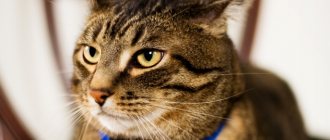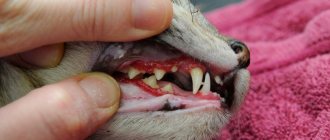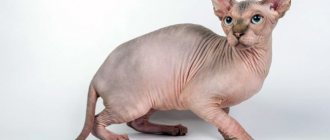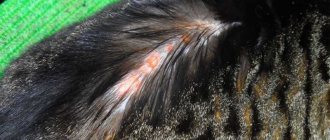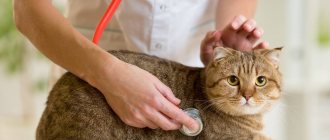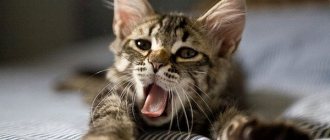Fleas in cats are quite common. They are found in domestic animals as often as worms. It is impossible to protect your pet from infection 100%. Even if the cat does not have an outdoor run, there is always the possibility of parasite larvae being carried from the street onto shoes or an adult insect entering through the threshold of the front door or ceiling cracks.
One flea will not drink much blood and traces of its presence are almost impossible to detect, but it is capable of leaving numerous offspring, which over time will cause a lot of trouble not only for the animal, but also for its owner.
The essence of the problem
The most common place where cat acne appears is the chin. Dark dots are least likely to be seen on the tail. Fleas or other parasites leave their waste products anywhere on the animal's body. In advanced cases, the spots on the cat’s fur are localized in the following areas :
- folds on the paws;
- inner thighs;
- eyelids;
- nipples;
- jaws.
© shutterstock
Dark spots can also be found around the anus. If multiple black rashes appear on your pet's skin, you should see a veterinarian.
Treatment of a pet for an ailment
After examination, a qualified specialist prescribes comprehensive treatment, which is carried out at home or in a veterinary clinic. It includes:
- Local processing. Tar soap, specialized shampoo, antiseptic solutions, and a bandage soaked in calendula tincture are used.
- Taking prescribed medications. Prescribed in more advanced cases, in the presence of the development of a secondary infection. A monthly intake of an individually selected vitamin complex is recommended.
- Injections. If necessary, medications are selected by the attending physician.
- Adjustment of the usual diet. During treatment and recovery, the pet is transferred to a low-fat diet.
You might be interested in: Why is my cat's cheek swollen?
Symptoms
If black specks appear on a cat's skin, the pet owner should check for other symptoms of the disease. For example, a cat may suffer :
- baldness;
- swelling of the body;
- redness of the skin;
- small pimples that increase in size and number over time.
Pay attention to your pet's behavior. The appearance of black dots on a cat’s body is often accompanied by itching, due to which the animal becomes restless and constantly itches. Only an experienced veterinarian can make an accurate diagnosis after conducting the necessary research work.
Diagnostic results help to find out the exact cause of the appearance of dark spots on the fur and skin of a pet. It may turn out that the grains are due to the activity of parasites, a fungal infection, or as a result of a skin biopsy. A timely veterinary examination will allow you to exclude similar diseases, which include :
- demodicosis;
- cat scabies;
- dermatophytosis;
- allergic reactions;
- eosinophilic granuloma.
The black dots that appear under the cat's fur are most likely skin plugs clogged with excess sebum, or a manifestation of an internal disease.
© shutterstock
Symptoms of acne
The following symptoms are typical for this disease:
- Redness of the skin;
- The appearance of swelling in the area where blackheads accumulate;
- Development of ulcers, hair loss;
If left untreated for a long time, these symptoms often cause anxiety, the pet becomes nervous and irritable, and may show aggression. In addition, the cat begins to scratch the damaged area, thereby increasing the risk of a new infection and deterioration in overall health.
An examination by a specialist and taking a scraping will help rule out the presence of diseases with similar symptoms. These include:
- Diseases of the stomach and liver. Caused by poor diet or complications after an illness. Lead to rashes all over the cat's body.
- Demodecosis. Characterized by the presence of subcutaneous mites. It is characterized by the appearance of ulcers, itching and hair loss. Easily transmitted to other animals.
- Allergy. Common causes are a reaction to food, collar, litter. It is characterized by the appearance of pimples or black spots in the cat’s fur, redness of the skin and itching.
- Ringworm. The development is provoked by a fungus, as a result of which peeling and rashes appear on the cat’s skin, which lead to itching and baldness.
In addition to the above reasons, a strong argument indicating the need for examination by a veterinarian is a deterioration in the pet’s general health, refusal to eat, vomiting, lethargy and constant drowsiness. After conducting a visual examination, the doctor will prescribe the necessary examination, which may include various tests - skin scraping, fungal exclusion analysis and biopsy.
Why do black spots appear in cat fur?
Acne in cats most often appears on the chin. This is due to the fact that there is practically no hair on this part of the body. It is where a large number of sebaceous glands are concentrated. They become contaminated when animals eat food, when dirt gets into them. But pollution is not always to blame for the fact that black rashes appear around the cat’s mouth. All cats are very clean, and caring owners provide the pet with good care. It just sometimes happens that black dots appear in a cat’s fur due to bad heredity.
You can treat acne, but you cannot completely get rid of the pathology. The only thing the owner can do in this case is to control the situation using hygiene products.
Black dots appear in a pet's fur for the following reasons::
- improper, disturbed nutrition;
- hormonal disbalance;
- problems in the central nervous system
- problems in the liver or gastrointestinal tract.
The appearance of black dots in a cat’s ears indicates poor quality care for the animal. Acne and pimples in this area of the body appear due to the accumulation of large amounts of sulfur. There is very little sulfur in the ears of healthy cats, and therefore it does not disrupt the functioning of the sebaceous glands. But this component accumulates over time, and if you do not keep your ears clean, the glands become clogged and acne forms. This problem is especially relevant for cats with large and open ears.
Excessive grooming also contributes to the formation of black spots on a cat’s body. If the owner constantly and thoroughly cleans wax from the pet’s ears, the protective layer is erased, and the glands, in order to restore it, produce double the amount of wax.
If a cat has black specks in its fur, and the animal is wearing a flea collar around its neck, perhaps the cause of the problem lies in the accessory itself. Sometimes sensitive animals experience irritation or an allergic reaction to the material from which the collar is made. Sometimes the accessory compresses the skin, preventing air from entering it, which also provokes the appearance of black spots in the fur.
© shutterstock
Rashes in the form of black dots also appear due to the development of contact dermatitis or other skin pathologies, due to which the production of fat increases and the sebaceous glands intensify their work. In any case, in order to understand why black dots appeared in the cat’s fur and body, it is necessary to show the animal to a veterinarian and carry out a diagnosis.
Black dots appeared on the cat's chin, what are they?
Black spots on the chin.
Blackheads are acne, a skin disease characterized by inflammation of the sebaceous glands, the appearance of blackheads on the animal’s chin.
Main factors of appearance:
- stress;
- improper care;
- primary skin diseases;
- congenital pathology of the genesis of the sebaceous glands;
- anomaly in the genesis of hair follicles;
- low immunity;
- failure to comply with sanitary and hygienic standards during feeding.
It should be noted that there are no clear reasons for the development of the disease and this is an approximate list of factors.
Development of the disease
Improper metabolic processes can cause blackheads to appear on the chin.
It is believed that the development of the disease is associated with improper metabolic processes in the skin , with the formation of fats, amino acids, and keratin. These components give the skin strength and elasticity. In a healthy body, the upper keratinized layer of skin is exfoliated and replaced with young cells.
In pathological processes, separation does not occur. Old, dead cells mix with new ones to form acne. The development of pathology does not depend on the sex of the animal, its breed, or age . A one-time appearance of blackheads is harmless, does not cause discomfort, goes away on its own, unnoticed, however, there are a number of cases of chronic disease, with possible complications in the form of a secondary infection.
How to treat acne in cats?
The owner can treat blackheads independently. To do this, he needs to lubricate the pet’s skin with salicylic alcohol, and also include vitamins in his diet. But it is worth considering that salicylic alcohol has a sharp, unpleasant odor that is poorly tolerated by cats. Instead, you can use chlorhexidine (the drug has a good effect in the treatment of acne). They are recommended to lubricate the cat’s skin and fur, and then dry it well.
Tar shampoo or soap has an excellent drying effect. You can also cope with comedones using cucumber lotion. Such products will dry the skin and stabilize the sebaceous glands. Dark grains dry out and fall off a few days after treatment. If the animal has long hair, grains get stuck in it, and in this case they need to be combed out with a comb. It is advisable to switch the cat to a low-fat diet and change the food to a more expensive and medicinal one (at least until recovery).
If the cat owner decides to treat the pet himself, he needs to take into account the following recommendations:
- you need to comb out grains of wool carefully, without using a metal brush (it will further damage the skin);
- areas affected by black grains should not be lubricated with drying compounds too much, since the skin will dry out greatly from such exposure;
- alcohol preparations, iodine and brilliant green should be used carefully and not for long (if you smear them on damaged skin for a long time, the sebaceous glands will begin to work more actively, which will lead to a worsening of the condition);
- It is recommended to apply the ointment with a thin ball, otherwise the pet’s skin will not breathe and dermatitis will reappear.
To remove blackheads from a cat’s fur, you can also use folk remedies..
- A decoction of yarrow is used to wipe black spots on a cat’s lips.
- The affected areas can be treated with celandine (or a lotion can be made from this plant).
- Black spots in the fur are smeared with fresh pumpkin (cut) three times a day.
- A herbal mixture of chamomile and calendula flowers, to which 2 crushed furatsilin tablets are added, is used to treat black spots in a cat’s fur 2 times a day.
© shutterstock
Clotrimazole 1% or Chlorophyllipt works well in treating blackheads on a pet's face. Such preparations should be applied pointwise, without rubbing into the skin. Sulfur ointment is also applied on top.
Treatment of blackheads in fur should be suspended if such symptoms appear.:
- irritation of the skin (you need to wait until the redness goes away and the inflammatory process subsides);
- an increase in the area of the rash (this most often indicates that the selected course of treatment was ineffective);
- recovery came and the dots disappeared.
If your cat’s acne does not start, it can be cured with cosmetics within 7 days. If the treatment measures taken did not bring the desired result, and the number of black spots has increased, you need to show your pet to a veterinarian. Most likely the problem is physiological in nature and requires additional diagnostics and inpatient therapy.
Flea control products
Today there are many effective anti-flea products. All of them can be divided into several main types:
In general, if a cat has fleas for the first time, choosing a remedy can be quite difficult, because it is not always possible to predict whether it will cause an allergy or not. Here it is not advisable to act by trial and error, but it is better to immediately consult a veterinarian.
Fleas, like many other types of insects, undergo a complete transformation in their development. Actually, that’s what they’re called: insects with a full cycle of transformation. This means that the eggs laid by the female flea hatch into larvae that are very different from adult fleas in both their appearance and lifestyle.
White grains (microscopic balls)
White specks on cats' fur can only be noticed upon careful inspection.
One of the strange manifestations of cat malaise is white grains or microscopic balls that fall off the animal’s fur. They are not noticed immediately. At first, they only evoke puzzled glances from the owner and a silent question in his eyes. Where do the mysterious grains come from and what are they?
Prevention
It is important to prevent flea infestations. To do this you need:
- Clean, wash, dry and hide shoes immediately upon returning from the street.
- Keep your living space clean and carry out wet cleaning regularly.
- Wash curtains and vacuum carpets at least once a month.
- Change bed linen weekly.
- Prevent rodents from entering the house.
- Examine your cat thoroughly every week. In this case, you should pay attention to the skin - it must be clean.
Return to contents

